Paper Menu >>
Journal Menu >>
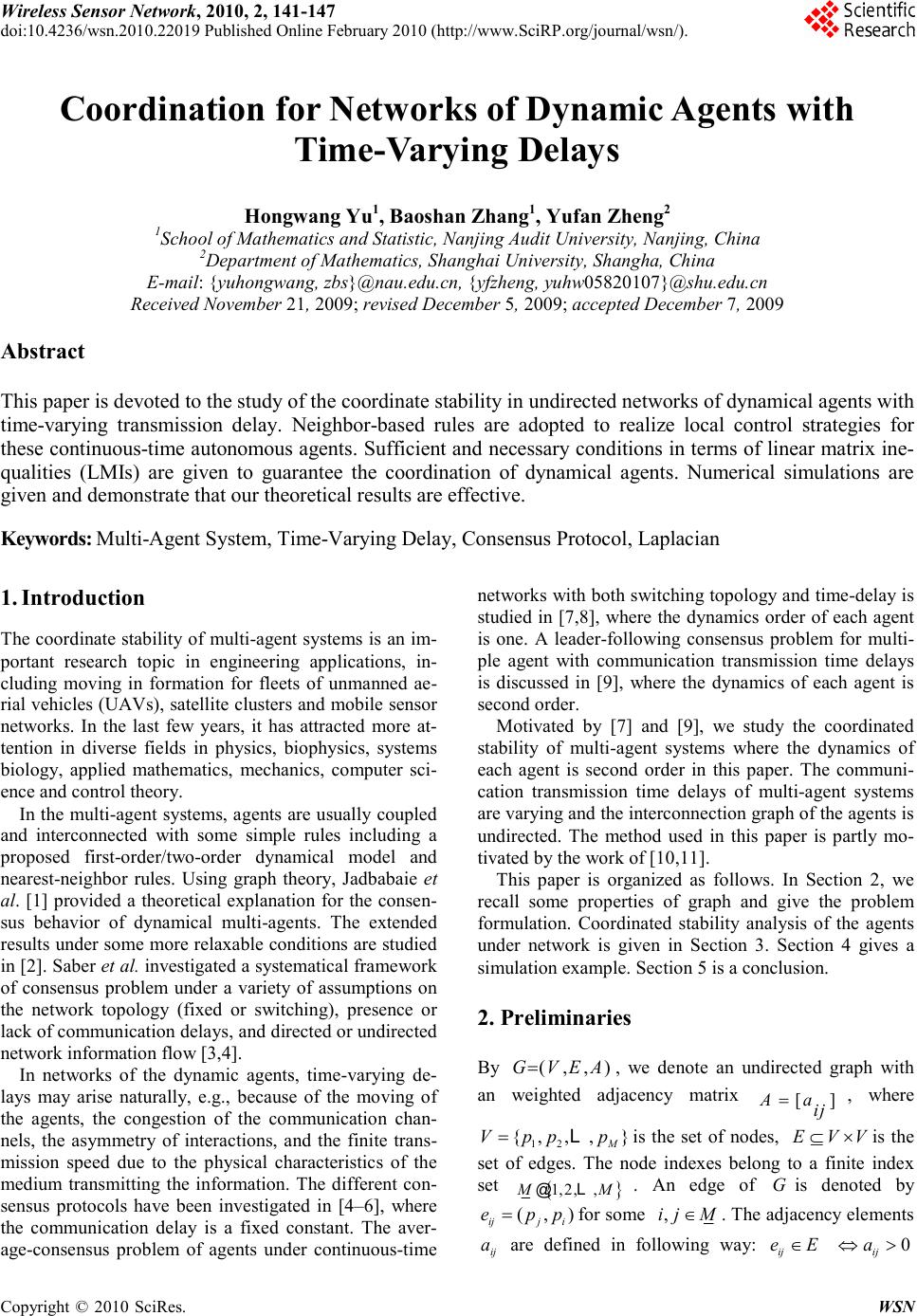 Wireless Sensor Network, 2010, 2, 141-147 doi:10.4236/wsn.2010.22019 Published Online February 2010 (http://www.SciRP.org/journal/wsn/). Copyright © 2010 SciRes. WSN Coordination for Networks of Dynamic Agents with Time-Varying Delays Hongwang Yu1, Baoshan Zhang1, Yufan Zheng2 1School of Mathematics and Statistic, Nanjing Audit University, Nanjing, China 2Department of Mathematics, Shanghai University, Shangha, China E-mail: {yuhongwang, zbs}@nau.edu.cn, {yfzheng, yuhw05820107}@shu.edu.cn Received November 21, 2009; revised December 5, 2009; accepted December 7, 2009 Abstract This paper is devoted to the study of the coordinate stability in undirected networks of dynamical agents with time-varying transmission delay. Neighbor-based rules are adopted to realize local control strategies for these continuous-time autonomous agents. Sufficient and necessary conditions in terms of linear matrix ine- qualities (LMIs) are given to guarantee the coordination of dynamical agents. Numerical simulations are given and demonstrate that our theoretical results are effective. Keywords: Multi-Agent System, Time-Varying Delay, Consensus Protocol, Laplacian 1. Introduction The coordinate stability of multi-agent systems is an im- portant research topic in engineering applications, in- cluding moving in formation for fleets of unmanned ae- rial vehicles (UAVs), satellite clusters and mobile sensor networks. In the last few years, it has attracted more at- tention in diverse fields in physics, biophysics, systems biology, applied mathematics, mechanics, computer sci- ence and control theory. In the multi-agent systems, agents are usually coupled and interconnected with some simple rules including a proposed first-order/two-order dynamical model and nearest-neighbor rules. Using graph theory, Jadbabaie et al. [1] provided a theoretical explanation for the consen- sus behavior of dynamical multi-agents. The extended results under some more relaxable conditions are studied in [2]. Saber et al. investigated a systematical framework of consensus problem under a variety of assumptions on the network topology (fixed or switching), presence or lack of communication delays, and directed or undirected network information flow [3,4]. In networks of the dynamic agents, time-varying de- lays may arise naturally, e.g., because of the moving of the agents, the congestion of the communication chan- nels, the asymmetry of interactions, and the finite trans- mission speed due to the physical characteristics of the medium transmitting the information. The different con- sensus protocols have been investigated in [4–6], where the communication delay is a fixed constant. The aver- age-consensus problem of agents under continuous-time networks with both switching topology and time-delay is studied in [7,8], where the dynamics order of each agent is one. A leader-following consensus problem for multi- ple agent with communication transmission time delays is discussed in [9], where the dynamics of each agent is second order. Motivated by [7] and [9], we study the coordinated stability of multi-agent systems where the dynamics of each agent is second order in this paper. The communi- cation transmission time delays of multi-agent systems are varying and the interconnection graph of the agents is undirected. The method used in this paper is partly mo- tivated by the work of [10,11]. This paper is organized as follows. In Section 2, we recall some properties of graph and give the problem formulation. Coordinated stability analysis of the agents under network is given in Section 3. Section 4 gives a simulation example. Section 5 is a conclusion. 2. Preliminaries By (,,) GVEA = , we denote an undirected graph with an weighted adjacency matrix [] Aa ij =, where 12 {,,,} M Vppp = L is the set of nodes, EVV ⊆× is the set of edges. The node indexes belong to a finite index set { } 1,2,, MM @L . An edge of G is denoted by (,) ijji epp =for some , ijM ∈ . The adjacency elements ij a are defined in following way: ij eE ∈ 0 ij a ⇔> 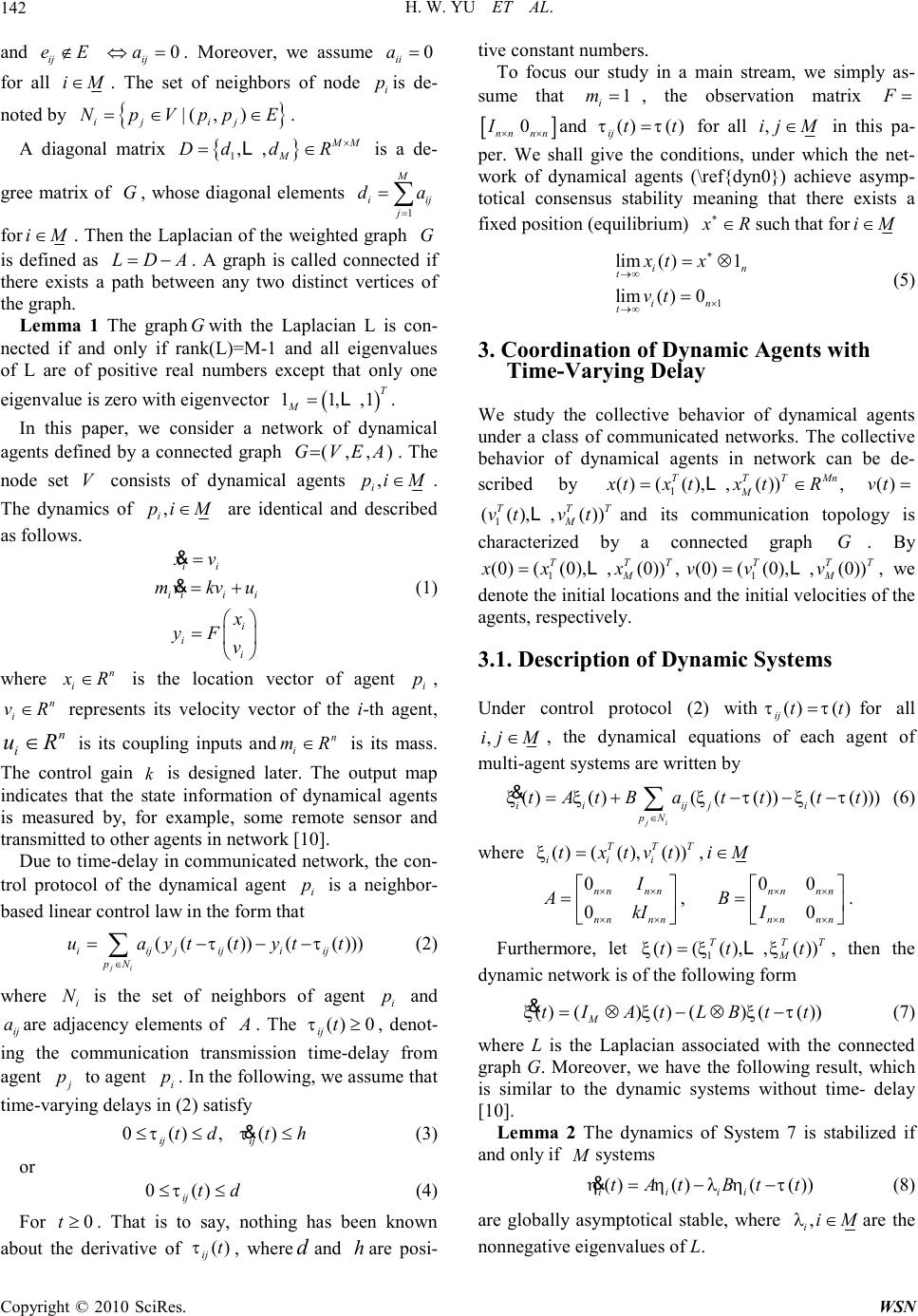 H. W. YU ET AL. Copyright © 2010 SciRes. WSN 142 and ij eE ∉ 0 ij a ⇔= . Moreover, we assume 0 ii a = for all iM ∈ . The set of neighbors of node i p is de- noted by { } |(,) ijij NpVppE =∈∈. A diagonal matrix { } 1,, MM M DddR × =∈ L is a de- gree matrix of G , whose diagonal elements 1 M iij j da = = ∑ for iM ∈ . Then the Laplacian of the weighted graph G is defined as LDA =− . A graph is called connected if there exists a path between any two distinct vertices of the graph. Lemma 1 The graph G with the Laplacian L is con- nected if and only if rank(L)=M-1 and all eigenvalues of L are of positive real numbers except that only one eigenvalue is zero with eigenvector ( ) 11,,1 T M=L. In this paper, we consider a network of dynamical agents defined by a connected graph (,,) GVEA = . The node set V consists of dynamical agents , i piM ∈. The dynamics of , i piM ∈ are identical and described as follows. ii iiii i i i xv mvkvu x yF v = =+ = & & (1) where n i xR ∈ is the location vector of agent i p , n i vR ∈ represents its velocity vector of the i-th agent, n i uR ∈ is its coupling inputs and n i mR ∈ is its mass. The control gain k is designed later. The output map indicates that the state information of dynamical agents is measured by, for example, some remote sensor and transmitted to other agents in network [10]. Due to time-delay in communicated network, the con- trol protocol of the dynamical agent i p is a neighbor- based linear control law in the form that ((())(())) ji iijjijiij pN uayttytt ττ ∈ =−−− ∑ (2) where i N is the set of neighbors of agent i p and ij a are adjacency elements of A . The ()0 ij tτ ≥ , denot- ing the communication transmission time-delay from agent j p to agent i p . In the following, we assume that time-varying delays in (2) satisfy 0(),() ijij tdth ττ ≤≤≤ & (3) or 0() ij td τ ≤≤ (4) For 0 t ≥ . That is to say, nothing has been known about the derivative of () ij t τ , where d and h are posi- tive constant numbers. To focus our study in a main stream, we simply as- sume that 1 i m = , the observation matrix F = [ ] 0 nnnn I×× and ()() ij tt ττ = for all , ijM ∈ in this pa- per. We shall give the conditions, under which the net- work of dynamical agents (\ref{dyn0}) achieve asymp- totical consensus stability meaning that there exists a fixed position (equilibrium) xR ∗ ∈ such that for iM ∈ 1 lim()1 lim()0 in t in t xtx vt ∗ →∞ × →∞ =⊗ = (5) 3. Coordination of Dynamic Agents with Time-Varying Delay We study the collective behavior of dynamical agents under a class of communicated networks. The collective behavior of dynamical agents in network can be de- scribed by 1 ()((),,()), TTTMn M xtxtxtR=∈ L () vt = 1 ((),,()) TTT M vtvt L and its communication topology is characterized by a connected graph G . By 1 (0)((0),,(0)), TTT M xxx= L 1 (0)((0),,(0)) TTT M vvv= L , we denote the initial locations and the initial velocities of the agents, respectively. 3.1. Description of Dynamic Systems Under control protocol (2) with ()() ij tt ττ =for all , ijM ∈ , the dynamical equations of each agent of multi-agent systems are written by ()()((())(())) ji iiijji pN tAtBatttt ξξξτξτ ∈ =+−−− ∑ & (6) where ()((),()) TTT iii txtvt ξ=, iM ∈ 0 0 nnnn nnnn I AkI ×× ×× = , 00 0 nnnn nnnn BI ×× ×× = . Furthermore, let 1 ()((),,()) TTT M ttt ξξξ= L , then the dynamic network is of the following form ()()()()(()) M tIAtLBtt ξξξτ=⊗−⊗− & (7) where L is the Laplacian associated with the connected graph G. Moreover, we have the following result, which is similar to the dynamic systems without time- delay [10]. Lemma 2 The dynamics of System 7 is stabilized if and only if M systems ()()(()) iiii tAtBtt ηηλητ=−− & (8) are globally asymptotical stable, where , i iM λ∈are the nonnegative eigenvalues of L. 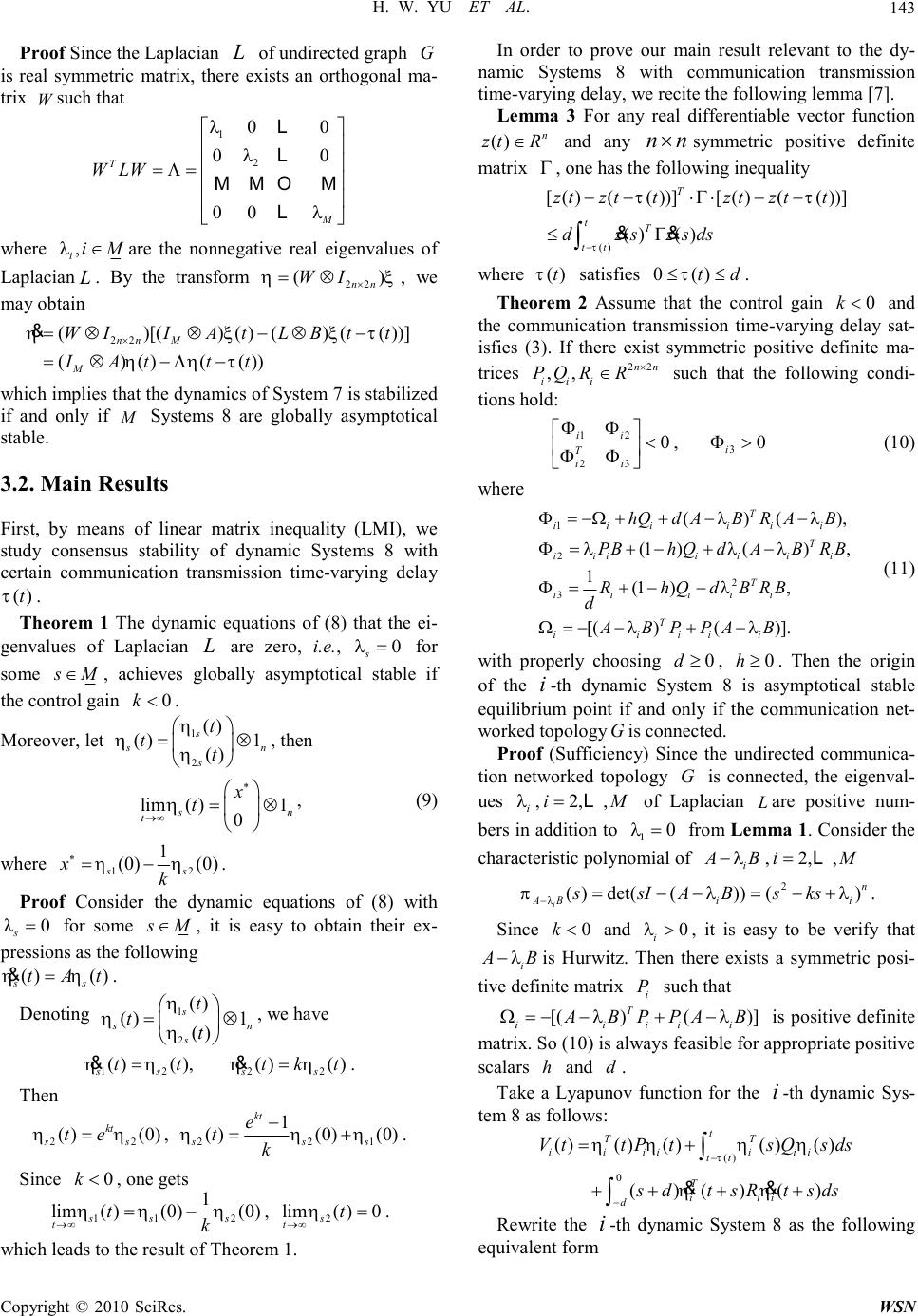 H. W. YU ET AL. Copyright © 2010 SciRes. WSN 143 Proof Since the Laplacian L of undirected graph G is real symmetric matrix, there exists an orthogonal ma- trix W such that 1 2 00 00 00 T M WLW λ λ λ =Λ= L L MMOM L where , i iM λ∈are the nonnegative real eigenvalues of Laplacian L . By the transform 22 () nn WI ηξ × =⊗ , we may obtain 22 ()[()()()(())] ()()(()) nnM M WIIAtLBtt IAttt ηξξτ ηητ × =⊗⊗−⊗− =⊗−Λ− & which implies that the dynamics of System 7 is stabilized if and only if M Systems 8 are globally asymptotical stable. 3.2. Main Results First, by means of linear matrix inequality (LMI), we study consensus stability of dynamic Systems 8 with certain communication transmission time-varying delay () t τ . Theorem 1 The dynamic equations of (8) that the ei- genvalues of Laplacian L are zero, i.e., 0 s λ = for some sM ∈ , achieves globally asymptotical stable if the control gain 0 k < . Moreover, let 1 2 () ()1 () s sn s t tt η ηη =⊗ , then lim()1 0 sn t x tη∗ →∞ =⊗ , (9) where 12 1 (0)(0) ss xk ηη ∗ =− . Proof Consider the dynamic equations of (8) with 0 s λ = for some sM ∈ , it is easy to obtain their ex- pressions as the following ()() ss tAt ηη= & . Denoting 1 2 () ()1 () s sn s t tt η ηη =⊗ , we have 1222 ()(), ()() ssss tttkt ηηηη== && . Then 22 ()(0) kt ss teηη=, 221 1 ()(0)(0) kt sss e t k ηηη − =+. Since 0 k < , one gets 112 1 lim()(0)(0) sss t tk ηηη →∞ =− , 2 lim()0 s ttη →∞ = . which leads to the result of Theorem 1. In order to prove our main result relevant to the dy- namic Systems 8 with communication transmission time-varying delay, we recite the following lemma [7]. Lemma 3 For any real differentiable vector function () n ztR ∈ and any nn × symmetric positive definite matrix Γ , one has the following inequality () [()(())][()(())] ()() T tT tt ztzttztztt dzszsds τ ττ − −−⋅Γ⋅−− ≤Γ ∫ && where () t τ satisfies 0() td τ ≤≤ . Theorem 2 Assume that the control gain 0 k < and the communication transmission time-varying delay sat- isfies (3). If there exist symmetric positive definite ma- trices 22 ,, nn iii PQRR × ∈ such that the following condi- tions hold: 12 23 0 ii T ii ΦΦ < ΦΦ , 3 0 i Φ> (10) where 1 2 2 3 ()(), (1)(), 1(1), [()()]. T iiiiii T iiiiiii T iiiii T iiiii hQdABRAB PBhQdABRB RhQdBRB d ABPPAB λλ λλλ λ λλ Φ=−Ω++−− Φ=+−+− Φ=+−− Ω=−−+− (11) with properly choosing 0 d ≥ , 0 h ≥ . Then the origin of the i -th dynamic System 8 is asymptotical stable equilibrium point if and only if the communication net- worked topology G is connected. Proof (Sufficiency) Since the undirected communica- tion networked topology G is connected, the eigenval- ues i λ , 2,, iM = L of Laplacian L are positive num- bers in addition to 1 0 λ = from Lemma 1. Consider the characteristic polynomial of i AB λ −, 2,, iM = L 2 ()det(())() i n ABii ssIABsks λ πλλ −=−−=−+ . Since 0 k < and 0 i λ > , it is easy to be verify that i AB λ −is Hurwitz. Then there exists a symmetric posi- tive definite matrix i P such that [()()] T iiiii ABPPAB λλΩ=−−+− is positive definite matrix. So (10) is always feasible for appropriate positive scalars h and d . Take a Lyapunov function for the i -th dynamic Sys- tem 8 as follows: () 0 ()()()()() ()()() t TT iiiiiii tt T iii d VttPtsQsds sdtsRtsds τ ηηηη ηη − − =+ ++++ ∫ ∫&& Rewrite the i -th dynamic System 8 as the following equivalent form 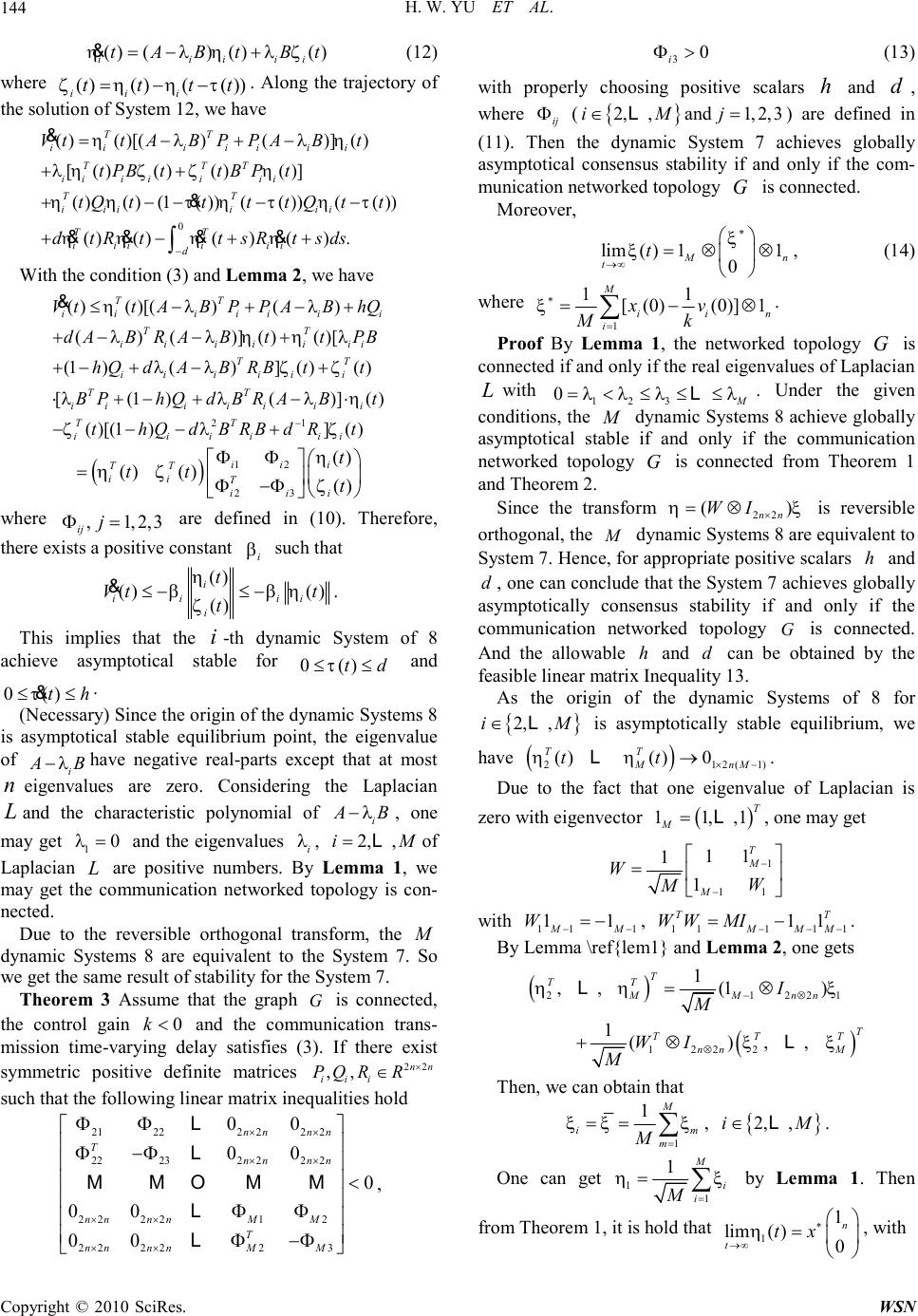 H. W. YU ET AL. Copyright © 2010 SciRes. WSN 144 ()()()() iiiii tABtBt ηληλζ=−+ & (12) where ()()(()) iii tttt ζηητ =−− . Along the trajectory of the solution of System 12, we have 0 ()()[()()]() [()()()()] ()()(1())(())(()) ()()()(). TT iiiiiii TTT iiiiiii TT iiiiii TT iiiiii d VttABPPABt tPBttBPt tQttttQtt dtRttsRtsds ηλλη ληζζη ηητητητ ηηηη − =−+− ++ +−−−− +−++ ∫ & & &&&& With the condition (3) and Lemma 2, we have 21 ()()[()() ()()]()()[ (1)()]()() [(1)()]() ()[(1)]() TT iiiiiii TT iiiiiii TT iiiiii TT iiiiiii TT iiiiii VttABPPABhQ dABRABttPB hQdABRBtt BPhQdBRABt thQdBRBdRt ηλλ λληηλ λλζζ λλλη ζλζ − ≤−+−+ +−−+ +−+−+ ⋅+−+−⋅ −−−+ & ( ) 12 23 () ()() () iii TT ii T iii t tt t η ηζ ζ ΦΦ = Φ−Φ where ,1,2,3 ij j Φ= are defined in (10). Therefore, there exists a positive constant i β such that () ()() () i iiii i t Vtt t η ββη ζ ≤−≤− &. This implies that the i -th dynamic System of 8 achieve asymptotical stable for 0() td τ ≤≤ and 0() th τ ≤≤ & . (Necessary) Since the origin of the dynamic Systems 8 is asymptotical stable equilibrium point, the eigenvalue of i AB λ − have negative real-parts except that at most n eigenvalues are zero. Considering the Laplacian L and the characteristic polynomial of i AB λ −, one may get 1 0 λ = and the eigenvalues i λ , 2,, iM = L of Laplacian L are positive numbers. By Lemma 1, we may get the communication networked topology is con- nected. Due to the reversible orthogonal transform, the M dynamic Systems 8 are equivalent to the System 7. So we get the same result of stability for the System 7. Theorem 3 Assume that the graph G is connected, the control gain 0 k < and the communication trans- mission time-varying delay satisfies (3). If there exist symmetric positive definite matrices 22 ,, nn iii PQRR × ∈ such that the following linear matrix inequalities hold 21222222 22232222 222212 222223 00 00 0 00 00 nnnn Tnnnn nnnnMM T nnnnMM ×× ×× ×× ×× ΦΦ Φ−Φ < ΦΦ Φ−Φ L L MMOMM L L , 3 0 i Φ> (13) with properly choosing positive scalars h and d , where ij Φ ( { } 2,, iM ∈ L and 1,2,3 j = ) are defined in (11). Then the dynamic System 7 achieves globally asymptotical consensus stability if and only if the com- munication networked topology G is connected. Moreover, lim()11 0 Mn ttξ ξ∗ →∞ =⊗⊗ , (14) where 1 11 [(0)(0)]1 M iin i xv Mk ξ∗ = =−⊗ ∑. Proof By Lemma 1, the networked topology G is connected if and only if the real eigenvalues of Laplacian L with 123 0 M λλλλ =<≤≤≤ L . Under the given conditions, the M dynamic Systems 8 achieve globally asymptotical stable if and only if the communication networked topology G is connected from Theorem 1 and Theorem 2. Since the transform 22 () nn WI ηξ × =⊗ is reversible orthogonal, the M dynamic Systems 8 are equivalent to System 7. Hence, for appropriate positive scalars h and d , one can conclude that the System 7 achieves globally asymptotically consensus stability if and only if the communication networked topology G is connected. And the allowable h and d can be obtained by the feasible linear matrix Inequality 13. As the origin of the dynamic Systems of 8 for { } 2,, iM ∈ L is asymptotically stable equilibrium, we have ( ) 212(1) ()()0 TT MnM ttηη ×− →L. Due to the fact that one eigenvalue of Laplacian is zero with eigenvector ( ) 11,,1 T M=L, one may get 1 11 11 1 1 T M M WW M − − = with 111 11 MM W −− =− , 11111 11 TT MMM WWMI −−− =− . By Lemma \ref{lem1} and Lemma 2, one gets ( ) ( ) 21221 1222 1 ,,(1) 1 (),, T TT MMnn T TTT nnM I M WI M ηηξ ξξ −⊗ ⊗ =⊗ +⊗ L L Then, we can obtain that 1 1M im m M ξξξ = == ∑ , { } 2,, iM ∈ L . One can get 11 1M i i M ηξ = = ∑ by Lemma 1. Then from Theorem 1, it is hold that 1 1 lim() 0 n ttxη∗ →∞ = , with 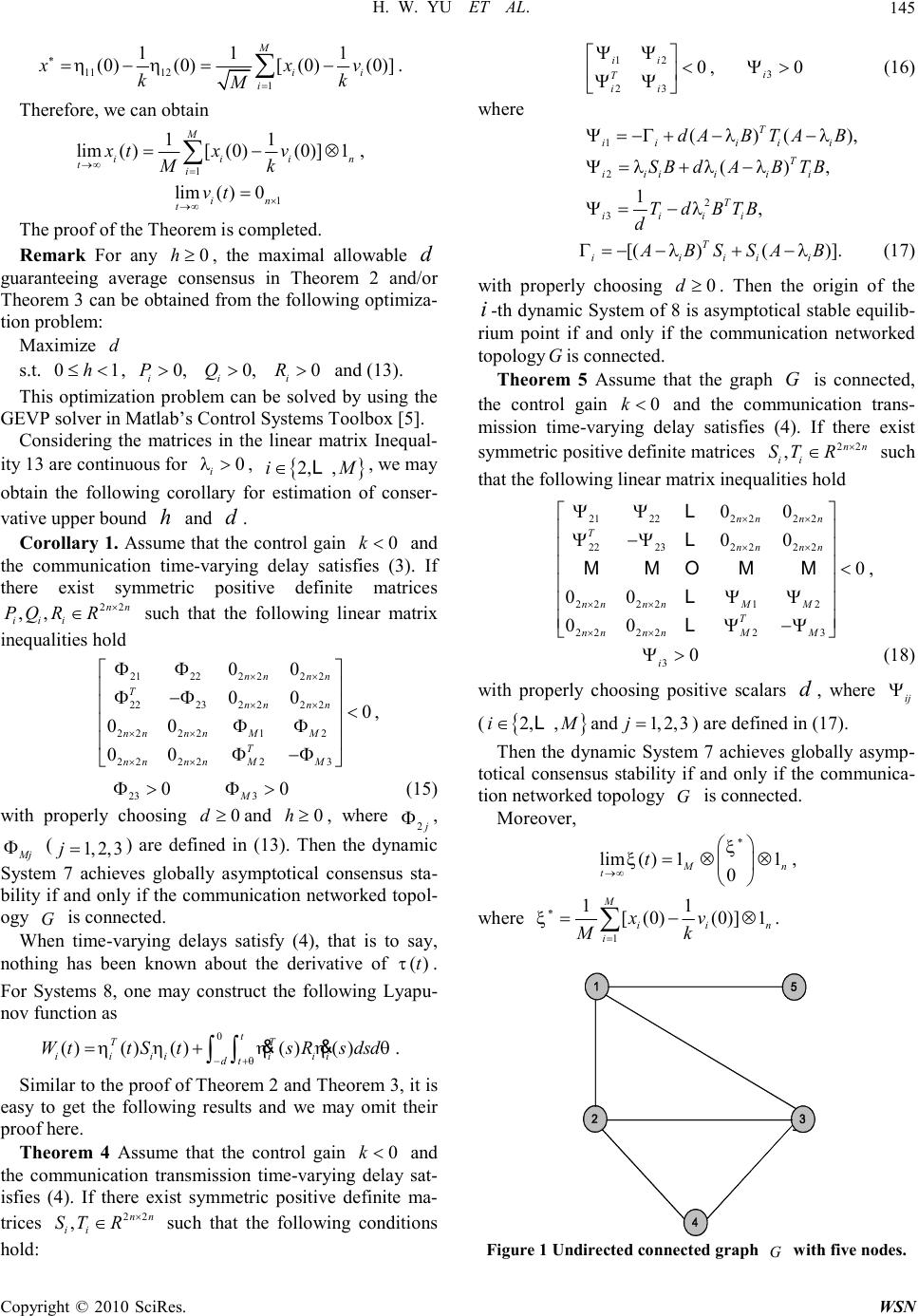 H. W. YU ET AL. Copyright © 2010 SciRes. WSN 145 1112 1 111 (0)(0)[(0)(0)] M ii i xxv kk M ηη ∗ = =−=− ∑. Therefore, we can obtain 1 11 lim()[(0)(0)]1 M iiin ti xtxv Mk →∞ = =−⊗ ∑, 1 lim()0 in tvt × →∞ = The proof of the Theorem is completed. Remark For any 0 h ≥ , the maximal allowable d guaranteeing average consensus in Theorem 2 and/or Theorem 3 can be obtained from the following optimiza- tion problem: Maximize d s.t. 01 h ≤< , 0,0,0 iii PQR >>> and (13). This optimization problem can be solved by using the GEVP solver in Matlab’s Control Systems Toolbox [5]. Considering the matrices in the linear matrix Inequal- ity 13 are continuous for 0 i λ > , { } 2,, iM ∈ L , we may obtain the following corollary for estimation of conser- vative upper bound h and d . Corollary 1. Assume that the control gain 0 k < and the communication time-varying delay satisfies (3). If there exist symmetric positive definite matrices 22 ,, nn iii PQRR × ∈ such that the following linear matrix inequalities hold 21222222 22232222 222212 222223 00 00 0 00 00 nnnn Tnnnn nnnnMM T nnnnMM ×× ×× ×× ×× ΦΦ Φ−Φ < ΦΦ Φ−Φ , 23 0 Φ> 3 0 M Φ> (15) with properly choosing 0 d ≥ and 0 h ≥ , where 2 j Φ , Mj Φ ( 1,2,3 j = ) are defined in (13). Then the dynamic System 7 achieves globally asymptotical consensus sta- bility if and only if the communication networked topol- ogy G is connected. When time-varying delays satisfy (4), that is to say, nothing has been known about the derivative of () t τ . For Systems 8, one may construct the following Lyapu- nov function as 0 ()()()()() t TT iiiiiii dt WttStsRsdsd θ ηηηηθ −+ =+ ∫∫ && . Similar to the proof of Theorem 2 and Theorem 3, it is easy to get the following results and we may omit their proof here. Theorem 4 Assume that the control gain 0 k < and the communication transmission time-varying delay sat- isfies (4). If there exist symmetric positive definite ma- trices 22 , nn ii STR × ∈ such that the following conditions hold: 12 23 0 ii T ii ΨΨ < ΨΨ , 3 0 i Ψ> (16) where 1 2 ()(), (), T iiiii T iiiiii dABTAB SBdABTB λλ λλλ Ψ=−Γ+−− Ψ=+− 2 3 1 , T iiii TdBTB dλΨ=− [()()]. T iiiii ABSSAB λλΓ=−−+− (17) with properly choosing 0 d ≥ . Then the origin of the i -th dynamic System of 8 is asymptotical stable equilib- rium point if and only if the communication networked topology G is connected. Theorem 5 Assume that the graph G is connected, the control gain 0 k < and the communication trans- mission time-varying delay satisfies (4). If there exist symmetric positive definite matrices 22 , nn ii STR × ∈ such that the following linear matrix inequalities hold 21222222 22232222 222212 222223 00 00 0 00 00 nnnn Tnnnn nnnnMM T nnnnMM ×× ×× ×× ×× ΨΨ Ψ−Ψ < ΨΨ Ψ−Ψ L L MMOMM L L , 3 0 i Ψ> (18) with properly choosing positive scalars d , where ij Ψ ( { } 2,, iM ∈ L and 1,2,3 j = ) are defined in (17). Then the dynamic System 7 achieves globally asymp- totical consensus stability if and only if the communica- tion networked topology G is connected. Moreover, lim()11 0 Mn ttξ ξ∗ →∞ =⊗⊗ , where 1 11 [(0)(0)]1 M iin i xv Mk ξ ∗ = =−⊗ ∑. Figure 1 Undirected connected graph G with five nodes. 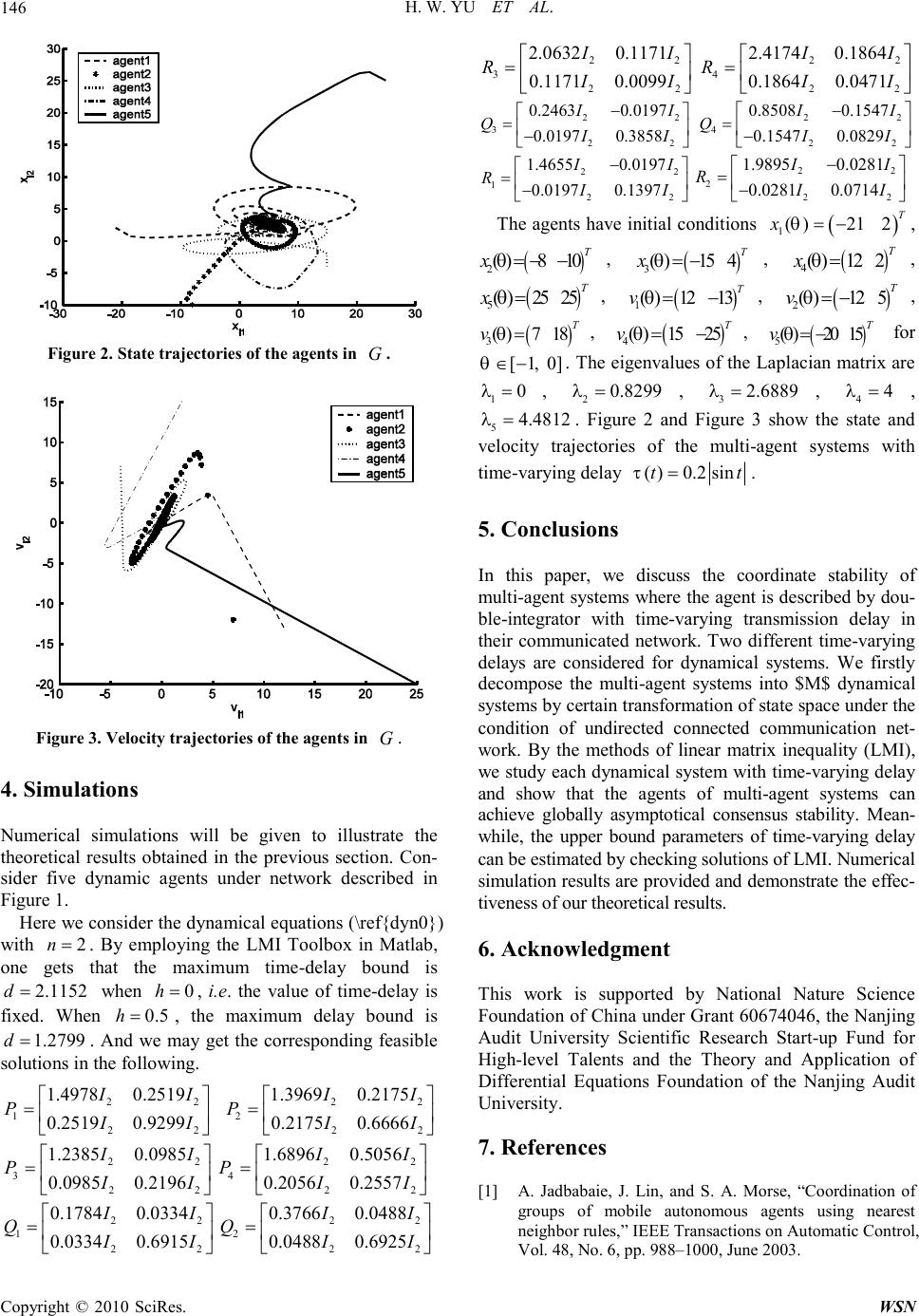 H. W. YU ET AL. Copyright © 2010 SciRes. WSN 146 Figure 2. State trajectories of the agents in G . Figure 3. Velocity trajectories of the agents in G . 4. Simulations Numerical simulations will be given to illustrate the theoretical results obtained in the previous section. Con- sider five dynamic agents under network described in Figure 1. Here we consider the dynamical equations (\ref{dyn0}) with 2 n = . By employing the LMI Toolbox in Matlab, one gets that the maximum time-delay bound is 2.1152 d= when 0 h = , i.e. the value of time-delay is fixed. When 0.5 h=, the maximum delay bound is 1.2799 d=. And we may get the corresponding feasible solutions in the following. 22 1 22 1.49780.2519 0.25190.9299 II P II = 22 2 22 1.39690.2175 0.21750.6666 II P II = 22 3 22 1.23850.0985 0.09850.2196 II P II = 22 4 22 1.68960.5056 0.20560.2557 II P II = 22 1 22 0.17840.0334 0.03340.6915 II Q II = 22 2 22 0.37660.0488 0.04880.6925 II Q II = 22 3 22 2.06320.1171 0.11710.0099 II R II = 22 4 22 2.41740.1864 0.18640.0471 II R II = 22 322 0.24630.0197 0.01970.3858 II Q II − = − 22 422 0.85080.1547 0.15470.0829 II Q II − = − 22 122 1.46550.0197 0.01970.1397 II R II − = − 22 222 1.98950.0281 0.02810.0714 II R II − = − The agents have initial conditions ( ) 1 ()212 T xθ=− , ( ) 2 ()810 T xθ=−− , ( ) 3 ()154 T xθ=− , ( ) 4 ()122 T xθ=, ( ) 5 ()2525 T xθ=, ( ) 1 ()1213 T vθ=− , ( ) 2 ()125 T vθ=− , ( ) 3 ()718 T vθ=, ( ) 4 ()1525 T vθ=−, ( ) 5 ()2015 T vθ=− for [1,0] θ ∈− . The eigenvalues of the Laplacian matrix are 1 0 λ = , 2 0.8299 λ=, 3 2.6889 λ=, 4 4 λ = , 5 4.4812 λ=. Figure 2 and Figure 3 show the state and velocity trajectories of the multi-agent systems with time-varying delay ()0.2sin tt τ=. 5. Conclusions In this paper, we discuss the coordinate stability of multi-agent systems where the agent is described by dou- ble-integrator with time-varying transmission delay in their communicated network. Two different time-varying delays are considered for dynamical systems. We firstly decompose the multi-agent systems into $M$ dynamical systems by certain transformation of state space under the condition of undirected connected communication net- work. By the methods of linear matrix inequality (LMI), we study each dynamical system with time-varying delay and show that the agents of multi-agent systems can achieve globally asymptotical consensus stability. Mean- while, the upper bound parameters of time-varying delay can be estimated by checking solutions of LMI. Numerical simulation results are provided and demonstrate the effec- tiveness of our theoretical results. 6. Acknowledgment This work is supported by National Nature Science Foundation of China under Grant 60674046, the Nanjing Audit University Scientific Research Start-up Fund for High-level Talents and the Theory and Application of Differential Equations Foundation of the Nanjing Audit University. 7. References [1] A. Jadbabaie, J. Lin, and S. A. Morse, “Coordination of groups of mobile autonomous agents using nearest neighbor rules,” IEEE Transactions on Automatic Control, Vol. 48, No. 6, pp. 988–1000, June 2003.  H. W. YU ET AL. Copyright © 2010 SciRes. WSN 147 [2] W. Ren and R. W. Beard, “Consensus seeking in multi- agent systems under dynamically changing interaction topologies,” IEEE Transactions on Automatic Control, Vol. 50, No. 5, pp. 655–661, May 2005. [3] R. O. Saber and R. M. Murray, “Consensus problems in networks of agents with switching topology and time- delays,” IEEE Transactions on Automatic Control, Vol. 49, No. 9, pp. 1520–1533, September 2004. [4] R. O. Saber, J. A. Fax, and R. M. Murray, “Consensus and cooperation in networked multiagent systems,” Pro- ceedings of the IEEE, Vol. 95, No. 1, pp. 215–240, Janu- ary 2007. [5] L. Moreau, “Stability of multiagent systems with time- dependent communication,” IEEE Transactions on Automatic Control, Vol. 50, No. 2, pp. 169–182, Febru- ary 2005. [6] D. Lee and W. M. Spong, “Agreement with non-uniform information delays,” Proceedings of the 2006 American Control Conference, pp. 756–761, 2006. [7] P. Lin and Y. Jia, “Average consensus in networks of multi-agents with both switching topology and coupling time-delay,” Physica A, Vol. 387, pp. 303–313, 2008. [8] Y. Sun, L. Wang, and G. Xie, “Average consensus in directed networks of dynamic agents with time-varying communication delays,” Proceedings of the 45th IEEE Conference on Decision and Control, pp. 3393–3398, 2006. [9] J. Hu and Y. Hong, “Leader-following coordination of multi-agent systems with coupling time delays, ” Physica A, Vol. 374, pp. 853–863, 2007. [10] J. A. Fax and R. M. Murray, “Information flow and co- operative control of vehicle formations,” IEEE Transac- tions on Automatic Control, Vol. 49, No. 9, pp. 1465– 1476, 2004. [11] G. Xie and L. Wang, “Information flow and cooperative control of vehicle formations,” International Journal of Robust and Nonlinear Control, Vol. 17, pp. 941–959, 2007. [12] L. Moreau, “Stability of continuous-time distributed con- sensus algorithms,” In Proceedings of the 43rd IEEE Conference on Decision and Control, Atlantis, Paradise Island, Bahamas, pp. 3998–4003, 2004. [13] Dongjun Lee and Mark W. Spong, “Agreement with non-uniform information delays”, In Proceedings of the 2006 American Control Conference, Minnesota, USA, June 14–16, 2006. [14] M. Cao, A. S. Morse, and B. D. O. Anderson, “Reaching a consensus using delayed information”, In Proceedings of the 45th IEEE Conference on Decision and Control, San Diego, pp. 3375–3380, 2006. [15] N. Biggs, “Algebraic, graph theory,” Cambridge: Cam- bridge University Press, 1994. [16] H. Yu, Y. Zheng, “Global behavior of dynamical agents in directed network,” Proceedings of the 26th Chinese Control Conference, pp. 557–561, 2007. [17] A. Isidori, “Nonlinear control systems II,” London: Communications and Control Engineering Series, Springer-Verlag, 1999. [18] R. A. Horn and C. R. Johnson, “Matrix analysis,” Cam- bridge: Cambridge University Press, 1987. |

